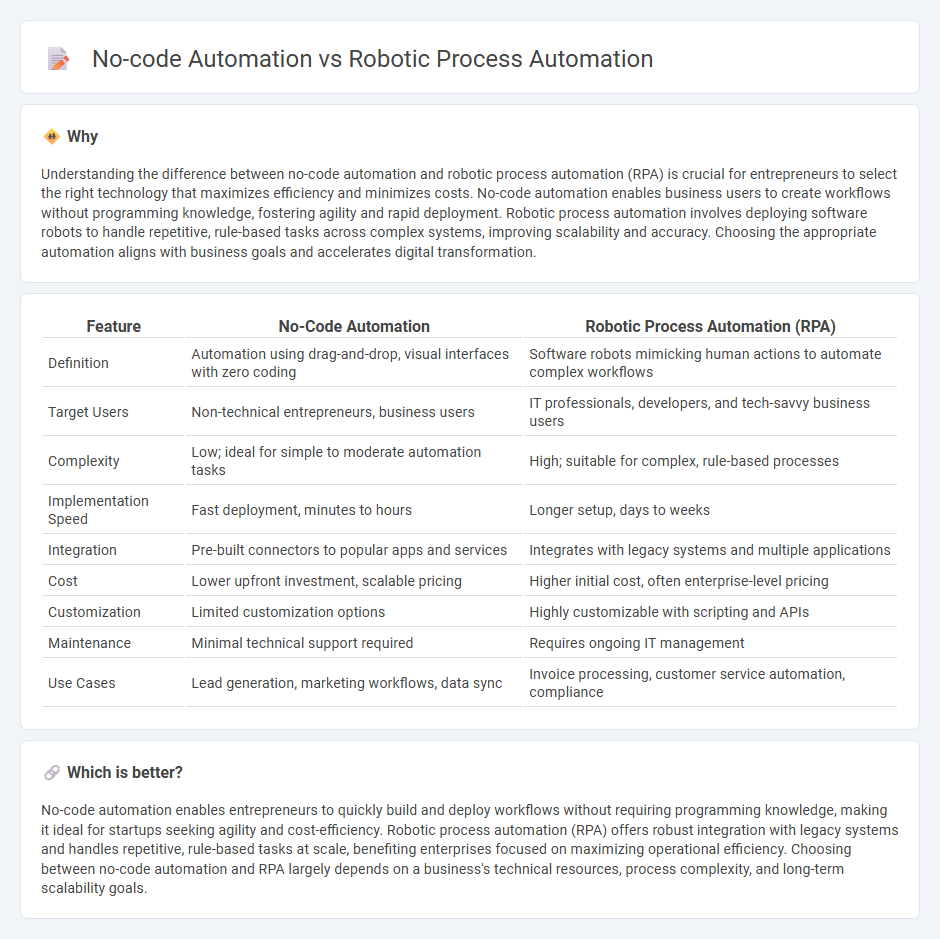
Entrepreneurship increasingly leverages No-Code Automation and Robotic Process Automation (RPA) to optimize operational efficiency. No-Code Automation empowers entrepreneurs to create workflows without programming expertise, while RPA uses software robots to mimic human tasks and enhance process accuracy. Explore the differences and benefits of these technologies to drive your business growth.
Why it is important
Understanding the difference between no-code automation and robotic process automation (RPA) is crucial for entrepreneurs to select the right technology that maximizes efficiency and minimizes costs. No-code automation enables business users to create workflows without programming knowledge, fostering agility and rapid deployment. Robotic process automation involves deploying software robots to handle repetitive, rule-based tasks across complex systems, improving scalability and accuracy. Choosing the appropriate automation aligns with business goals and accelerates digital transformation.
Comparison Table
| Feature | No-Code Automation | Robotic Process Automation (RPA) |
|---|---|---|
| Definition | Automation using drag-and-drop, visual interfaces with zero coding | Software robots mimicking human actions to automate complex workflows |
| Target Users | Non-technical entrepreneurs, business users | IT professionals, developers, and tech-savvy business users |
| Complexity | Low; ideal for simple to moderate automation tasks | High; suitable for complex, rule-based processes |
| Implementation Speed | Fast deployment, minutes to hours | Longer setup, days to weeks |
| Integration | Pre-built connectors to popular apps and services | Integrates with legacy systems and multiple applications |
| Cost | Lower upfront investment, scalable pricing | Higher initial cost, often enterprise-level pricing |
| Customization | Limited customization options | Highly customizable with scripting and APIs |
| Maintenance | Minimal technical support required | Requires ongoing IT management |
| Use Cases | Lead generation, marketing workflows, data sync | Invoice processing, customer service automation, compliance |
Which is better?
No-code automation enables entrepreneurs to quickly build and deploy workflows without requiring programming knowledge, making it ideal for startups seeking agility and cost-efficiency. Robotic process automation (RPA) offers robust integration with legacy systems and handles repetitive, rule-based tasks at scale, benefiting enterprises focused on maximizing operational efficiency. Choosing between no-code automation and RPA largely depends on a business's technical resources, process complexity, and long-term scalability goals.
Connection
No-code automation platforms empower entrepreneurs to build and deploy automated workflows without coding skills, accelerating digital transformation in startups. Robotic Process Automation (RPA) complements no-code tools by mimicking repetitive human tasks across applications, enhancing operational efficiency and reducing errors. Together, these technologies streamline business processes, enabling rapid innovation and scalability in entrepreneurial ventures.
Key Terms
Workflow Optimization
Robotic Process Automation (RPA) utilizes software robots to mimic repetitive tasks, enhancing workflow optimization by automating complex processes across multiple systems. No-code automation empowers users to build workflows through intuitive interfaces without programming knowledge, accelerating deployment and reducing dependency on IT resources. Explore how combining RPA and no-code solutions can significantly refine your organization's workflow efficiency.
Scalability
Robotic Process Automation (RPA) offers high scalability by automating complex, rule-based tasks across multiple systems, making it ideal for large enterprises with diverse workflows. No-code automation excels in rapid deployment and ease of use but may face limitations when scaling to handle intricate processes or extensive workflows. Explore more about how scalability impacts automation strategy to determine the best fit for your business needs.
Technical Barrier
Robotic Process Automation (RPA) typically involves higher technical barriers, requiring knowledge of scripting, software integration, and process workflows to automate complex tasks effectively. In contrast, no-code automation platforms are designed to minimize these challenges by providing user-friendly, drag-and-drop interfaces that enable business users without programming experience to build automation workflows. Explore the technical differences and implementation strategies to determine which solution best fits your organization's needs.
Source and External Links
What is Robotic Process Automation (RPA)? - RPA is a business automation technology using software robots to emulate human tasks by integrating APIs and UI interactions, enhancing efficiency and enabling intelligent automation with AI and machine learning.
What is Robotic Process Automation - RPA Software - RPA automates repetitive workflows by emulating human interactions with systems, reducing errors and costs while increasing employee productivity and enabling faster digital transformation.
Robotic Process Automation (RPA) - RPA bots automate repetitive and standardized tasks like document processing, invoice handling, customer service, HR onboarding, and supply chain operations, improving accuracy and operational speed.
 dowidth.com
dowidth.com